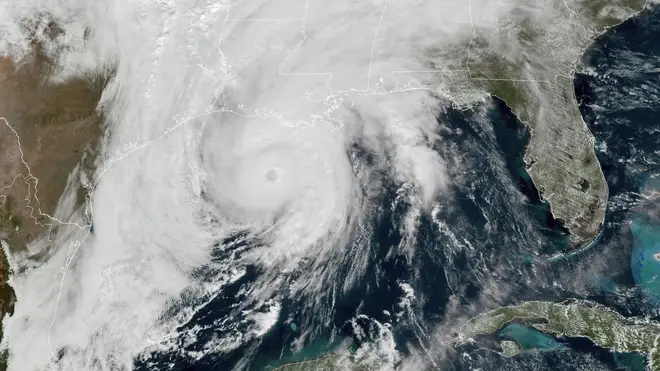
James O'Brien 10am - 1pm
28 October 2020, 23:24

Residents were bracing for Zeta, the 27th named storm of the season.
Hurricane Zeta crashed into storm-weary Louisiana on Wednesday with New Orleans squarely in its path, knocking out power to thousands in a Gulf Coast region already pounded by multiple storms this year.
Some roads were flooded near the coast, where forecasters said Zeta was making landfall around Terrebonne Bay near Cocodrie, an unincorporated fishing village with a marine laboratory but few if any full-time residents.
Streams of rainfall ran off roofs in New Orleans’ famed French Quarter, signs outside bars and restaurants swayed back and forth in the wind and palm trees along Canal Street whipped furiously.
A few trees were down, and one that fell across utility lines sparked a bright orange flash.
More than 100,000 customers were without electricity in Louisiana, including more than 77,000 in metro New Orleans.
Zeta had top sustained winds of 110mph as a Category 2 hurricane and was the 27th named storm of a historically busy Atlantic hurricane season — with over a month left before it ends.
Tropical storm warnings were issued as far away as the north Georgia mountains, highly unusual for the region.
New Orleans has been in the warning areas of seven previous storms that veered east or west this season. Zeta was staying on course.

Zeta had been predicted to hit as a relatively weak Category 1 hurricane, but Louisiana residents awoke to updated forecasts predicting a Category 2 at landfall around the southeastern part of the state.
“The good news for us — and look, you take good news where you can find it — the storm’s forward speed is 17 mph.
“That’s projected to increase, and so it’s going to get in and out of the area relatively quickly, and then we’re going to be able to assess the damage more quickly,” Governor John Bel Edwards said in an interview on The Weather Channel.
Officials urged people to take precautions and prepare to shelter in place, and a business-as-usual atmosphere in the morning in New Orleans diminished as the storm neared and grew stronger.
Traffic slowed, and restaurants and coffee shops shut down.
“This year, the storms have been coming back-to-back. They’ve been avoiding New Orleans but finally decided to come,” cookie shop worker Curt Brumfield said as he stowed empty boxes in rubbish bins outside and others boarded up the windows.
6 PM CDT Hurricane #Zeta update: Life-threatening storm surge and strong winds continue over southeastern Louisiana. https://t.co/bDPuXcHB38 pic.twitter.com/LCQSJ1ur9u
— National Hurricane Center (@NHC_Atlantic) October 28, 2020
Winds picked up and water rose above the docks in Jean Lafitte, a small fishing town south of New Orleans that takes its name from a French pirate.
Workers drove truckloads of sand to low-lying areas where thousands of sandbags were already stacked for previous storms.
“We’re going to get a lot of water fast,” said the mayor, Tim Kerner Jr.
“I’m optimistic regarding the tidal surge because of the speed of the storm, but we’re not going to take it for granted.”

Zeta’s wind, rain and storm surge reached more than 150 miles east of New Orleans.
In Mississippi, the city of Pass Christian ordered all boats out of the harbour, and Dauphin Island, Alabama, shut off water and sewer service in areas that typically are swamped in storms.
New Orleans officials announced that a turbine that generates power to the city’s ageing drainage pump system broke down on Sunday, with no quick repair in sight. There was enough power to keep the pumps operating if needed, but little excess power to tap if other turbines fail, officials said.
Officials said they were running through contingencies should there be other equipment problems.
Forecasts called for anywhere from two to six inches of rain to fall in the New Orleans area, but Zeta’s pace could mitigate the flood threat.
Before landfall, Zeta’s top winds had risen to just shy of a major, Category 3 storm, according to the US National Hurricane Centre.
On Tuesday, Zeta raked across Mexico’s Yucatan Peninsula, toppling trees and briefly cutting power to more than 300,000 people but causing no deaths.
It then regained strength over the Gulf of Mexico along a path slightly to the east of those of Hurricane Laura, which was blamed for at least 27 deaths in Louisiana in August, and Hurricane Delta, which exacerbated Laura’s damage in the same area weeks later.
Hurricane warnings stretched from Morgan City, Louisiana, to the Alabama/Mississippi state line, including Lake Pontchartrain and metropolitan New Orleans.